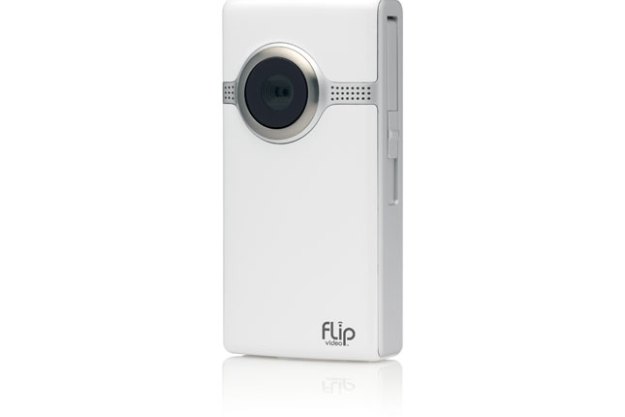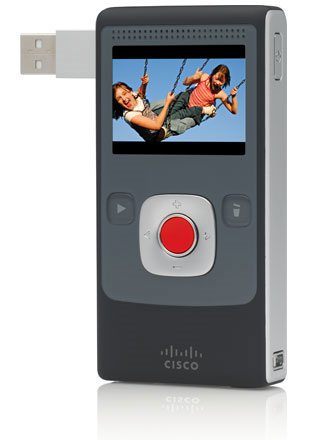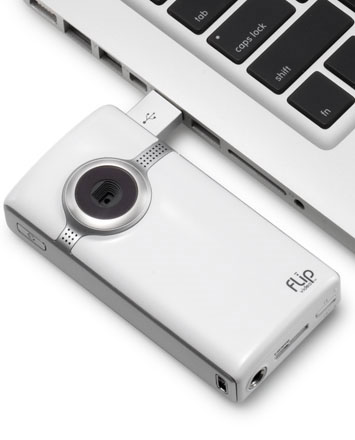
“The third generation of the Flip UltraHD brings smoother video, more flexible battery options and the ability to add third-party accessories.”
- Gyro-based anti-jitter
- 60 fps smoothes out footage
- 16-pin FlipPort allows third-party accessories
- Runs on both lithium ion cell and alkaline AAA
- Less natural color, less contrast than previous generation
- No still image capture
- Micro HD jack, no included cable or adapter
- Too expensive for too few capabilities
 Introduction
Introduction
As with all pocket camcorders, Flip video quality suffers when compared to full-sized models, a result mostly of lower-cost image processing chips, cheap lenses and footage that shakes like a bridegroom hearing the wedding march – the result of ineffective image stabilization. Flip has tried to address both the quality and jitter problems with its latest UltraHD, the UltraHD 3, but has both succeeded and failed in improving the world’s bestselling camcorder.
Features
Basically, all the UltraHD 3 does is shoot 1280 x 720p video at 60 fps (the 1-hour version captures video at 30 fps like the UltraHD 2), with footage stored internally. There are no picture-taking capabilities, no special effects, no SD card expansion. Literally, just point, shoot, then flip out the USB jack (hence its name) to transfer the footage using the embedded FlipShare software.

The UltraHD 3 takes a giant step forward in flexibility – it can run on either 3 AAAs (instead of UltraHD 2’s 2 AA) or an included lithium-ion rechargeable pack. Flip says you’ll get two hours of shooting on the alkaline, and 1.5 hours on the rechargeable.

Controls
Like all Flips, the UltraHD has a four-way toggle just below the 2-inch LCD: up-down controls zoom in record mode and adjust volume in play mode, left and right skips through clips, with a big red record button in the middle. There’s a play button on the left, and a trash button on the right. The power button is on the right perimeter, the flip-out USB jack on the left.
Accessories
Along with pending third-party FlipPort accessories, underwater cases and a variety of tripods and mounts, there’ll also be a wide-angle lens from Bower ($50) that attaches magnetically.
The FlipShare software now supports upload to Twitter and automatically adapts its download and playback to your PC’s video processor.
Video Quality
All pocket camcorder video suffers from jitter and jerkiness; it’s the nature of the beast. Electronic and digital image stabilization schemes often add grain or interpolation artifacts, and even more unnatural jitter as it tries to compensate for your unsteady hand.
Flip has come up with a chip-based gyroscope system similar to the gyro now found in superphones, to better isolate the image capture circuitry. Combined with its 60 fps frame rate, Flip video is substantially steadier and thankfully smoother, with none of the constantm nausea-inducing tics.
But while the UltraHD 3 improves jitter control, it takes a step backward in color and contrast. UltraHD 3 videos have a blue-ish tinge compared to footage from the UltraHD 2, and it doesn’t compensate for light and shadow as well as the UltraHD 2. UltraHD 2 footage from Grand Central Station, for instance, retains the actual color of the marble better than the 3. In the squirrel video, the second-gen model adjusts from shadow to sunlight far more effectively. In the deli scene, the countermen’s red shirts are far redder in the UltraHD 2 footage compared to the new model.
Conclusion
Smooth, balanced footage without tics and jerks trumps slightly-off color every time, and both the accessories and dual battery capabilities make the UltraHD 3 a far more flexible model than any in Flip’s line. But there are other pocketcams that capture higher-resolution video, megapixel stills, and endowed with more capabilities – if not the improved image stabilization or stupid-simple operation – at a similar price.
Highs:
- Gyro-based anti-jitter
- 60 fps smoothes out footage
- 16-pin FlipPort allows third-party accessories
- Runs on both lithium ion cell and alkaline AAA
Lows:
- Less natural color, less contrast than previous generation
- No still image capture
- Micro HD jack, no included cable or adapter
- Too expensive for too few capabilities
 Introduction
Introduction

